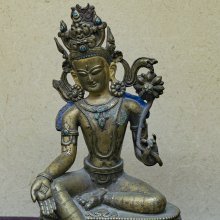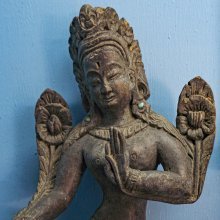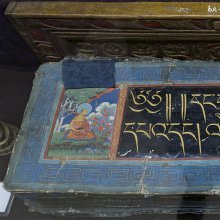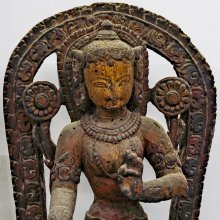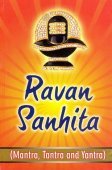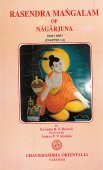Arya, Ārya, Āryā: 32 definitions
Introduction:
Arya means something in Buddhism, Pali, Hinduism, Sanskrit, Jainism, Prakrit, the history of ancient India, Marathi, Hindi. If you want to know the exact meaning, history, etymology or English translation of this term then check out the descriptions on this page. Add your comment or reference to a book if you want to contribute to this summary article.
Images (photo gallery)
(+27 more images available)
In Hinduism
Shaktism (Shakta philosophy)
Source: Wisdom Library: Śāktism1) Āryā (आर्या, “noble one”):—One of the names of Mahāsarasvatī (sattva-form of Mahādevī). Mahālakṣmī is one of the three primary forms of Devī. Not to be confused with Lakṣmī, she is a more powerful cosmic aspect (vyaṣṭi) of Devi and represents the guṇa (universal energy) named sattva. Also see the Devī Māhātmya, a Sanskrit work from the 5th century, incorporated into the Mārkaṇḍeya-Purāṇa.
2) Ārya (आर्य, “the noble-one”):—One of the names of Sarasvatī, the Hindu goddess of speech, eloquence and all forms of knowledge.
3) Ārya (आर्य) refers to one of the 53 gods to be worshipped and given pāyasa (rice boiled in milk) according to the Vāstuyāga rite in Śaktism (cf. Śāradātilaka-tantra III-V). The worship of these 53 gods happens after assigning them to one of the 64 compartment while constructing a Balimaṇḍapa. Vāstu is the name of a prodigious demon, who was killed by 53 gods (e.g., Ārya).

Shakta (शाक्त, śākta) or Shaktism (śāktism) represents a tradition of Hinduism where the Goddess (Devi) is revered and worshipped. Shakta literature includes a range of scriptures, including various Agamas and Tantras, although its roots may be traced back to the Vedas.
Purana and Itihasa (epic history)
Source: archive.org: Puranic EncyclopediaĀryā (आर्या).—One of the seven mothers who were present at the birth of Subrahmaṇya. (Śloka 13, Chapter 228, Vana Parva, Mahābhārata).
Source: Cologne Digital Sanskrit Dictionaries: The Purana Index1a) Ārya (आर्य).—Opposite of Mleccha.*
- * Vāyu-purāṇa 45. 93; 47. 49; 99. 404.
1b) Collective name of Aṅgiras' sons1 as opposed to mleccha.2 Their country was Bhāratavarṣa; side by side with mleccha in Kaliyuga.3
- 1) Bhāgavata-purāṇa IX. 4. 2; Brahmāṇḍa-purāṇa II. 16. 24.
- 2) Matsya-purāṇa 227. 198; 114. 20.
- 3) Matsya-purāṇa 121. 46-51; 273. 25; 274. 37.
2) Āryā (आर्या).—Dvaipāyanī—A river visited by Balarāma.*
- * Bhāgavata-purāṇa X. 79. 20.

The Purana (पुराण, purāṇas) refers to Sanskrit literature preserving ancient India’s vast cultural history, including historical legends, religious ceremonies, various arts and sciences. The eighteen mahapuranas total over 400,000 shlokas (metrical couplets) and date to at least several centuries BCE.
Natyashastra (theatrics and dramaturgy)
Source: Wisdom Library: Nāṭya-śāstra1) Āryā (आर्या) refers to a type of syllabic metre (vṛtta), according to the Nāṭyaśāstra chapter 16. There are find kinds of āryā-metres defined:
- Pathyā,
- Vipulā
- Capalā,
- Mukhacapalā,
- Jaghanacapalā.
2a) Ārya (आर्य, “noble one” or “sir”) refers to a specific “mode of address” (nāman) used in drama (nāṭya), according to Nāṭyaśāstra chapter 19.
Ārya is used in the following situations:
- Addressing Brahmins (as ārya, ‘noble one’),
- By persons inferior to Brahmins addressing ministers (as ārya, ‘sir’).
- By women not in their youth addressing their husband (as ārya, ‘noble one’),
- Addressing the elder brother (as ārya, ‘noble one’),
Āryā (“noble lady”) is used in the following situations:
- Addressing Brahmin ladies, nuns (liṅgasthā) or female ascetics (vratinī),
- Addressing a wife,
- Addressing priests’ and merchants’ wives (in love-making).

Natyashastra (नाट्यशास्त्र, nāṭyaśāstra) refers to both the ancient Indian tradition (shastra) of performing arts, (natya—theatrics, drama, dance, music), as well as the name of a Sanskrit work dealing with these subjects. It also teaches the rules for composing Dramatic plays (nataka), construction and performance of Theater, and Poetic works (kavya).
Chandas (prosody, study of Sanskrit metres)
Source: Shodhganga: a concise history of Sanskrit Chanda literature1) Āryā (आर्या) is a type of mātrāvṛtta (quantitative verse) described in the Āryāprakaraṇa section of the second chapter of Kedārabhaṭṭa’s Vṛttaratnākara. The Vṛttaratnākara is considered as most popular work in Sanskrit prosody, because of its rich and number of commentaries. Kedārabhaṭṭa (C. 950-1050 C.E.) was a celebrated author in Sanskrit prosody.
2) Āryā (आर्या) refers to one of the 34 mātrāvṛttas (syllabo-quantitative verse) dealt with in the Vṛttamaṇimañjūṣā, whose authorship could be traced (also see the “New Catalogus Catalogorum” XXXI. p. 7).
3) Āryā (आर्या) refers to one of the thirty mātrāvṛtta (quantitative verse) mentioned in the 331st chapter of the Agnipurāṇa. The Agnipurāṇa deals with various subjects viz. literature, poetics, grammar, architecture in its 383 chapters and deals with the entire science of prosody (e.g., the āryā metre) in 8 chapters (328-335) in 101 verses in total.
4) Āryā (आर्या) refers to one of the thirty-four mātrāvṛtta (quantitative verse) mentioned in the Garuḍapurāṇa. The Garuḍapurāṇa says āryā metre has eight gaṇas out of which the odds should not have ja-gaṇa. The sixth one may be ja-gaṇa or nagaṇa with laghu, and the foot should end with it (the sixth gaṇa) after the second laghu.

Chandas (छन्दस्) refers to Sanskrit prosody and represents one of the six Vedangas (auxiliary disciplines belonging to the study of the Vedas). The science of prosody (chandas-shastra) focusses on the study of the poetic meters such as the commonly known twenty-six metres mentioned by Pingalas.
Vaishnavism (Vaishava dharma)
Source: Pure Bhakti: Brhad BhagavatamrtamĀrya (आर्य) refers to:—Spiritually cultured person. (cf. Glossary page from Śrī Bṛhad-bhāgavatāmṛta).

Vaishnava (वैष्णव, vaiṣṇava) or vaishnavism (vaiṣṇavism) represents a tradition of Hinduism worshipping Vishnu as the supreme Lord. Similar to the Shaktism and Shaivism traditions, Vaishnavism also developed as an individual movement, famous for its exposition of the dashavatara (‘ten avatars of Vishnu’).
Jyotisha (astronomy and astrology)
Source: Wisdom Library: Brihat Samhita by VarahamihiraĀrya (आर्य) (Cf. Āryajana) refers to “worthy men”, according to the Bṛhatsaṃhitā (chapter 5), an encyclopedic Sanskrit work written by Varāhamihira mainly focusing on the science of ancient Indian astronomy astronomy (Jyotiṣa).—Accordingly, “If the sun and moon should begin to be eclipsed when only half risen, deceitful men will suffer as well as sacrificial rites. [...] If they should be eclipsed when in the sign of Aquarius (Kumbha), hill men, men of western countries, carriers, robbers, shephards, serpents, worthy men [i.e., ārya], lions, citizens and the people of Barbara will perish. If when in the sign of Pisces (Mīna), the products of the sea beach and of the sea, man of respectability and of learning and persons that live by water will suffer. Also those provinces will be affected which correspond to particular lunar mansions in which the eclipses happen to occur, as will be explained in the chapter (14) on Kūrmavibhāga”.

Jyotisha (ज्योतिष, jyotiṣa or jyotish) refers to ‘astronomy’ or “Vedic astrology” and represents the fifth of the six Vedangas (additional sciences to be studied along with the Vedas). Jyotisha concerns itself with the study and prediction of the movements of celestial bodies, in order to calculate the auspicious time for rituals and ceremonies.
General definition (in Hinduism)
Source: WikiPedia: HinduismĀryā meter is a meter used in Sanskrit and Prakrit verses. A verse in āryā metre is in four metrical feet called pādas. Unlike the majority of meters employed in classical Sanskrit, the āryā meter is based on the number of mātrās (morae) per pāda. A syllable containing a short vowel counts for one mātrā, and a syllable containing a long vowel or a short vowel followed by two consonants counts for two mātrās.
The basic āryā verse has 12, 18, 12 and 15 mātrās in the first, second, third, and fourth pādas respectively.
Vṛttaratnākara lists several other conditions:
- Odd numbered mātrā-gaṇas should not be ja-gaṇa.
- Sixth gaṇa should be ja-gaṇa.
In Buddhism
Tibetan Buddhism (Vajrayana or tantric Buddhism)
Source: archive.org: The Indian Buddhist IconographyĀryā (आर्या) is the Śakti of Vaiśrayaṇa, and together forms one of the eight Yakṣa and Śakti pairs occupying the double lotus in the sādhana of Jambhala (yab-yum form), as described in the 5th-century Sādhanamālā (a collection of sādhana texts that contain detailed instructions for rituals).—Accordingly, when represented in Yab-Yum, he sits on the moon under which there is a double lotus of eight petals. [...] The eight petals of the lotus seat are occupied by the eight Yakṣas [viz., Vaiśrayaṇa], who are identical in all respects with the principal figure. Each Yakṣa is accompanied by a Śakti [viz., Āryā] with whom he remains in Yab-Yum in the same way as Jambhala remains with Vasudhārā [...]. The Yakṣiṇīs are identical in form with Vasudhārā, who is yellow in complexion, carries the ears of corn and shows the Varada-mudrā in her two hands.]

Tibetan Buddhism includes schools such as Nyingma, Kadampa, Kagyu and Gelug. Their primary canon of literature is divided in two broad categories: The Kangyur, which consists of Buddha’s words, and the Tengyur, which includes commentaries from various sources. Esotericism and tantra techniques (vajrayāna) are collected indepently.
Mahayana (major branch of Buddhism)
Source: academia.edu: A Study and Translation of the GaganagañjaparipṛcchāĀrya (आर्य) refers to “noble (beings)”, according to the Gaganagañjaparipṛcchā: the eighth chapter of the Mahāsaṃnipāta (a collection of Mahāyāna Buddhist Sūtras).—Accordingly, “[...] If he is in the state of concentration, but ends up inan unpleasant situation, he is not irritated. Even thought he always manifests peacefulness to noble beings (ārya-jana), he makes flaming efforts in order to bring ordinary people to maturity. Being in the state of sameness in concentration, he still teaches those with irregular behaviour by means of various kinds of teachings. He does not see the irregular in terms of sameness, and he does not obstruct the irregular with sameness. Since he is unobstructed, he is called the meditator whose thought is just like open space, without any obstruction, he is called a meditator with great insight, and he is called the meditator who is not dependent on consciousness. When meditation is understood in this way, then the meditation of the Bodhisattva is like the expanse of open space, which is not dependent on anything”.

Mahayana (महायान, mahāyāna) is a major branch of Buddhism focusing on the path of a Bodhisattva (spiritual aspirants/ enlightened beings). Extant literature is vast and primarely composed in the Sanskrit language. There are many sūtras of which some of the earliest are the various Prajñāpāramitā sūtras.
In Jainism
General definition (in Jainism)
Source: archive.org: TrisastisalakapurusacaritraĀrya (आर्य) and Mleccha refers to the two-fold division of men born in Mānuṣottara and in the Antaradvīpas, situated in the “middle world” (madhyaloka), according to chapter 2.2 [ajitanātha-caritra] of Hemacandra’s 11th century Triṣaṣṭiśalākāpuruṣacaritra (“lives of the 63 illustrious persons”): a Sanskrit epic poem narrating the history and legends of sixty-three important persons in Jainism.
Accordingly:—“In these 35 zones on this side of Mānuṣottara and in the Antaradvīpas, men arise by birth; on the mountains, Meru, etc., by kidnapping and power of learning, in the 2½ continents and in 2 oceans. [...]. From the division into Āryas and Mlecchas they are two-fold. The Āryas have sub-divisions: kṣetra (country), jāti (caste), kula (family), karma (work), śilpa (craft), and bhāṣā (language)”.
Source: Encyclopedia of Jainism: Tattvartha Sutra 3: The Lower and middle worlds1) Ārya (आर्य) is the collective name for human beings of the most auspicious Bhogabhūmi (paradise). The bhogabhūmis refer to various regions situated within Jambūdvīpa: the first continent of the Madhya-loka (middle-word), according to the 2nd-century Tattvārthasūtra 3.10. What are the human beings of most auspicious Bhogabhūmi called? They are called Ārya. They use the wishing trees (kalpavṛkṣa) to get their food, clothing, etc. They are conceived when the life of their parents is just nine months only i.e. the parents die after giving birth to a twin (boy and a girl).
Jambūdvīpa (where live the Āryas) is in the centre of all continents and oceans; all continents and oceans are concentric circles with Jambūdvīpa in the centre. Like the navel is in the centre of the body, Jambūdvīpa is in the centre of all continents and oceans. Sumeru Mount is in the centre of Jambūdvīpa. It is also called Mount Sudarśana.
2) Ārya (आर्य, “civilized”) refers to one of the two types of human beings according to the 2nd-century Tattvārthasūtra 3.36.—The human beings who have virtues and live with virtuous people are called civilized (āryas). How many subclasses are there amongst the civilized people (ārya)? There are two subclasses of the civilized people, namely: those have attained extraordinary powers (ṛddhi) and those who are without such extraordinary powers.
Who are called civilized people who perform activities with attachment ‘sāvadhyakarma-ārya’? Those who perform the six occupations: defense (asi), professional and accounting (masi), agriculture (kṛṣi), education (vidhyā), trade (vāṇijya) and crafts (śilpa) activities and do not observe vows completely and become non observers of vows (avirati). They are called sāvadhyakarma-ārya.
Ārya (आर्य, “noble”).—In earlier ancient times, the word ārya (noble) and anārya (ignoble) were used for ethnically different groups of people. In the time of Lord Mahāvīra, these words acquired technical meaning. Ārya stood for the ethically superior people and anārya for the ethically inferior ones. In the Sutrakṛtāṅga, there is a mention of āryamārga (the path followed by the ārya (1.3.66). The word ārya-satya (noble truth) in Buddhism is well known. In the present context anārya appears to stand for one who does not believe in the discipline of ahimsā, the antidote of this is ārya who believes in such discipline.
The āryas say: “We however declare that no creature should be killed or tortured”. This is the view of the noble.
Source: The University of Sydney: A study of the Twelve ReflectionsĀrya (आर्य) refers to “noble man”, according to the 11th century Jñānārṇava, a treatise on Jain Yoga in roughly 2200 Sanskrit verses composed by Śubhacandra.—Accordingly, “[com.—Next, having spoken about (kathayitvā) the nature of death (kālasvarūpaṃ) in this way, he provides information (pratibodhayati) about the noble man (āryaṃ)]—The three worlds, which are made foolish by the action of the poison of lust, are fast asleep in this gaping mouth of Yama’s serpent which is marked by fangs of destruction. While this one whose disposition is pitiless is devouring everyone, certainly there is no way out from this for you, noble fellow (ārya), by any means [even] with some difficulty without knowledge of what is beyond the senses. [Thus ends the reflection on] helplessness”.

Jainism is an Indian religion of Dharma whose doctrine revolves around harmlessness (ahimsa) towards every living being. The two major branches (Digambara and Svetambara) of Jainism stimulate self-control (or, shramana, ‘self-reliance’) and spiritual development through a path of peace for the soul to progess to the ultimate goal.
India history and geography
Source: Project Gutenberg: Castes and Tribes of Southern India, Volume 1Arya (“venerable”) is one of the gotras (clans) among the Kurnis (a tribe of South India). Kurni is, according to the Census Report 1901, “a corruption of kuri (sheep) and vanni (wool), the caste having been originally weavers of wool”. The gotras (viz., Arya) are described as being of the Brāhman, Kshatriya, and Vaisya sub-divisions of the caste, and of Shanmukha’s Sudra caste.
Source: Cologne Digital Sanskrit Dictionaries: Indian Epigraphical GlossaryArya.—(CII 1), same as Vaiśya. Note: arya is defined in the “Indian epigraphical glossary” as it can be found on ancient inscriptions commonly written in Sanskrit, Prakrit or Dravidian languages.
--- OR ---
Ārya.—cf. Tamil ayyar (EI 25), the father. Cf. bhadatasa aya-Isipālitasa, ‘of the Reverend Lord Ṛṣipālita’ (Ind. Ant., Vol. XI, p. 29). (SII 1), a [Jain] saint. Note: ārya is defined in the “Indian epigraphical glossary” as it can be found on ancient inscriptions commonly written in Sanskrit, Prakrit or Dravidian languages.
--- OR ---
Āryā.—cf. āī (EI 9), the mother. Note: āryā is defined in the “Indian epigraphical glossary” as it can be found on ancient inscriptions commonly written in Sanskrit, Prakrit or Dravidian languages.

The history of India traces the identification of countries, villages, towns and other regions of India, as well as mythology, zoology, royal dynasties, rulers, tribes, local festivities and traditions and regional languages. Ancient India enjoyed religious freedom and encourages the path of Dharma, a concept common to Buddhism, Hinduism, and Jainism.
Languages of India and abroad
Marathi-English dictionary
Source: DDSA: The Molesworth Marathi and English Dictionary1) Ārya (आर्य).—a (S) Of a good family, noble, genteel, respectable. 2 Proper, suitable, becoming.
2) āryā (आर्या).—f (S) A kind of metre: each foot is equal to four short syllables or to two long and two short. It admits of many modifications. See As. R. Vol. 10, 400. 2 A stanza of this measure.
Source: DDSA: The Aryabhusan school dictionary, Marathi-English1) Ārya (आर्य).—a Of a good family; noble. Proper.
2) āryā (आर्या).—f A kind of metre. A stanza of this measure.
Marathi is an Indo-European language having over 70 million native speakers people in (predominantly) Maharashtra India. Marathi, like many other Indo-Aryan languages, evolved from early forms of Prakrit, which itself is a subset of Sanskrit, one of the most ancient languages of the world.
Sanskrit dictionary
Source: DDSA: The practical Sanskrit-English dictionaryArya (अर्य).—a. [ṛ-yat]
1) Excellent, best.
2) Respectable.
3) Attached, true, devoted.
4) Dear, kind; Ṛgveda 1. 123.1.
-ryaḥ 1 A master, lord; अर्यः प्रेम्णा नो तथा वल्लभस्य (aryaḥ premṇā no tathā vallabhasya) Śiśupālavadha 18.52; Śānti.1.18; तेन वह्येन हन्तासि त्वमर्यं पुरुषाशिनम् (tena vahyena hantāsi tvamaryaṃ puruṣāśinam) Bhaṭṭikāvya 6.51.
2) A man of the third tribe, Vaiśya. cf. अर्यः स्वामिवैश्ययोः (aryaḥ svāmivaiśyayoḥ) P.III.1.13. cf. also... अर्यस्तु बाहुजे (aryastu bāhuje), and स्यादर्यः स्वामिवणिजोः (syādaryaḥ svāmivaṇijoḥ) Nm.
-ryā 1 A mistress.
2) A woman of the Vaiśya tribe.
-ryī 1 The wife of a Vaiśya.
--- OR ---
Ārya (आर्य).—a. [ṛ-ṇyat]
1) Āryan, an inhabitant of आर्यावर्त (āryāvarta), Name of the race migrated into India in Vedic times.
2) Worthy of an Ārya.
3) Worthy, venerable, respectable, honourable, noble, high; यदार्यमस्यामभिलाषि मे मनः (yadāryamasyāmabhilāṣi me manaḥ) Ś.1.22; R.2.33; so आर्यवेषः (āryaveṣaḥ) respectable dress; oft. used in theatrical language as an honorific adjective and a respectful mode of address; आर्यचाणक्यः, आर्या अरुन्धती (āryacāṇakyaḥ, āryā arundhatī) &c.; आर्य (ārya) revered or honoured Sir; आर्ये (ārye) revered or honoured lady. The following rules are laid down for the use of आर्य (ārya) in addressing persons:-(1) वाच्यौ नटीसूत्रधारावार्यनाम्ना परस्परम् (vācyau naṭīsūtradhārāvāryanāmnā parasparam) | (2) वयस्येत्युत्तमैर्वाच्यो मध्यैरार्येति चाग्रजः (vayasyetyuttamairvācyo madhyairāryeti cāgrajaḥ) | (3) (vaktavyo) अमात्य आर्येति चेतरैः (amātya āryeti cetaraiḥ) | (4) स्वेच्छया नामभिर्विप्रैर्विप्र आर्येति चेतरैः (svecchayā nāmabhirviprairvipra āryeti cetaraiḥ) | S. D.431.
4) Noble, fine, excellent.
-ryaḥ 1 Name of the Hindu and Iranian people, as distinguished from अनार्य, दस्यु (anārya, dasyu) and दास (dāsa); विजानीह्यार्यान्ये च दस्यवः (vijānīhyāryānye ca dasyavaḥ) Ṛgveda 1.51.8.
2) A man who is faithful to the religion and laws of his country; कर्तव्यमाचरन् कार्यमकर्तव्यमनाचरन् । तिष्ठति प्रकृताचारे स वा आर्य इति स्मृतः (kartavyamācaran kāryamakartavyamanācaran | tiṣṭhati prakṛtācāre sa vā ārya iti smṛtaḥ) ||
3) Name of the first three castes (as opp. to śūdra).
4) respectable or honourable man, esteemed person; वृत्तेन हि भवत्यार्यो न धनेन न विद्यया (vṛttena hi bhavatyāryo na dhanena na vidyayā) Mb.; परमार्यः परमां कृपां बभार (paramāryaḥ paramāṃ kṛpāṃ babhāra) Bu. Ch.5.6.
5) A man of noble birth.
6) A man of noble character.
7) A master, owner.
8) A preceptor; वैमानि- कार्यसमभूमा (vaimāni- kāryasamabhūmā) Viś. Guṇā.124; Mu.3.33.
9) A friend.
1) A Vaiśya.
11) A father-in-law (as in āryaputra).
12) A Buddha.
13) (With the Buddhists) A man who has thought on the four chief principles of Buddhism and lives according to them.
14) A son of Manu Sāvarṇa.
-ryā 1 Name of Pārvatī.
2) A mother-in-law.
3) A respectable woman; यत्रार्या रुदती भीता पाण्डवानिदमब्रवीत् (yatrāryā rudatī bhītā pāṇḍavānidamabravīt) Mahābhārata (Bombay) 3.12.87.
4) Name of a metre; राजानमुद्दिश्य आर्यामिमां पपाठ (rājānamuddiśya āryāmimāṃ papāṭha) K. °gītiḥ f. A variety of the Āryā metre, see Appendix.
5) That which comes from truth; आराद् याता तत्त्वेभ्य इति आर्या (ārād yātā tattvebhya iti āryā).
-ryam 1 Virtue, sacredness; नहि दुष्टा- त्मनामार्यमावसत्यालये चिरम् (nahi duṣṭā- tmanāmāryamāvasatyālaye ciram) Rām.3.5.12.
2) Discrimination (viveka); कोपमार्येण यो हन्ति स वीरः पुरुषोत्तमः (kopamāryeṇa yo hanti sa vīraḥ puruṣottamaḥ) Rām.4.31.6.
Source: Cologne Digital Sanskrit Dictionaries: Edgerton Buddhist Hybrid Sanskrit DictionaryĀryā (आर्या).—name of a yakṣiṇī: Sādhanamālā 561.1, 11; 562.5.
Source: Cologne Digital Sanskrit Dictionaries: Shabda-Sagara Sanskrit-English DictionaryArya (अर्य) or Aryya.—mfn.
(-ryaḥ-ryā-ryaṃ) Excellent. m.
(-ryaḥ) 1. A master. 2. A man of the third tribe, the Vaisya. f.
(-ryā) 1. A woman of the third tribe. 2. The wife of a Vaisya. E. ṛ to go, yat affix, and ṭāp or ṅīp for the fem.; ṅīp is affixed, when the word is fem. with reference to the male.
--- OR ---
Ārya (आर्य) or Āryya.—mfn.
(-ryaḥ-ryā-ryaṃ) 1. Of a good family. 2. Respectable, venerable. 3. Apposite, proper. 4. To be sought or obtained. m.
(-ryaḥ) 1. A master, an owner. 2. A name of Buddha. 3. A friend. f.
(-ryā) 1. A name of Parvati. 2. A kind of metre, measured by feet, each foot being equal to four short syllables, or two long and two short; there are seven and a half feet in each verse of the couplet, equal to thirty and to twenty-seven syllabic instants: the regular form consists of alternate long and short verses, but it admits of eighty principal variations. E. ṛ to go, ṇyat affix; also arya.
Source: Cologne Digital Sanskrit Dictionaries: Benfey Sanskrit-English DictionaryArya (अर्य).—m., f. yā and yī, A man or woman of the third caste, [Daśakumāracarita] in
--- OR ---
Ārya (आर्य).—. I. m., f. yā, 1. Originally the name of the immigrated Indian people in opposition to the old inhabitants. In later times, the name of the three upper castes in opposition to the fourth, [Yājñavalkya, (ed. Stenzler.)] 2, 294; or to barbarians, Mahābhārata 14, 2137. Ii. fem. yā, The name of a metre. [Rājataraṅgiṇī] 5. 35. Iii. adj., f. yā. 1. Respectable, venerable, [Mānavadharmaśāstra] 8, 75; [Daśakumāracarita] in
Arya (अर्य).—1. (arya) [adjective] faithful, devoted, pious, attached, kind.
--- OR ---
Arya (अर्य).—2. [feminine] ā a man or woman of one of the first three castes, [especially] a Vaiśya.
--- OR ---
Ārya (आर्य).—([feminine] ā & ārī) belonging to the faithful or loyal, to one’s own race, i.e. Aryan, noble, reverend, honourable. [masculine] ([feminine] ā) an Aryan, a honourable man, [especially] one of the first three castes; also one’s senior, i.e. grandfather, great-grandfather, or elder brother. [feminine] ā mother (also [plural]) or wife of the elder brother; [vocative] [masculine] & [feminine] often in reverential address = your honour. [feminine] ā also [Name] of a metre.
Source: Cologne Digital Sanskrit Dictionaries: Aufrecht Catalogus Catalogorum1) Ārya (आर्य) as mentioned in Aufrecht’s Catalogus Catalogorum:—father of Cauṇḍappācārya, Ādityadeva and Mañcayāyya. Oxf. 371^b.
2) Āryā (आर्या):—stotra, by Ānandatīrtha. Rice. 268.
—by Vallabhācārya. Hall. p. 146.
—by Viṭṭhala Dīkṣita. Hall. p. 151.
—by Śaṅkarācārya. B. 2, 72. 4, 46.
3) Āryā (आर्या):—stotra, by Viṭṭhala Dīkṣita. Io. 1068.
Source: Cologne Digital Sanskrit Dictionaries: Monier-Williams Sanskrit-English Dictionary1) Arya (अर्य):—1. arya mfn. (2, once 3 [Ṛg-veda iv, 1, 7]) (√ṛ) kind, favourable, [Ṛg-veda]
2) attached to, true, devoted, dear, [Ṛg-veda]
3) excellent, [cf. Lexicographers, esp. such as amarasiṃha, halāyudha, hemacandra, etc.]
4) m. a master, lord, [Naighaṇṭuka, commented on by Yāska; Pāṇini 3-1, 103] (cf. 3. arya.)
5) 2. arya mf(ā)n. (= 1. arya) kind, favourable, [Ṛg-veda i, 123, 1.]
6) 3. arya m. (= 1. aiya) ‘master, lord’, a Vaiśya, [Vājasaneyi-saṃhitā] etc., [Pāṇini 3-1, 103]
7) Aryā (अर्या):—[from arya] f. a woman of the third caste, the wife of a Vaiśya, [Vājasaneyi-saṃhitā] etc., [Pāṇini 4-1, 49] [commentator or commentary]
8) Ārya (आर्य):—m. ([from] arya, √ṛ), a respectable or honourable or faithful man, an inhabitant of Āryāvarta
9) one who is faithful to the religion of his country
10) Name of the race which immigrated from Central Asia into Āryāvarta (opposed to an-ārya, dasyu, dāsa)
11) in later times Name of the first three castes (opposed to śūdra), [Ṛg-veda; Atharva-veda; Vājasaneyi-saṃhitā; Mahābhārata; Yājñavalkya; Pañcatantra] etc.
12) a man highly esteemed, a respectable, honourable man, [Pañcatantra; Śakuntalā] etc.
13) a master, an owner, [cf. Lexicographers, esp. such as amarasiṃha, halāyudha, hemacandra, etc.]
14) a friend, [cf. Lexicographers, esp. such as amarasiṃha, halāyudha, hemacandra, etc.]
15) a Vaiśya, [cf. Lexicographers, esp. such as amarasiṃha, halāyudha, hemacandra, etc.]
16) Buddha
17) (with Buddhists [Pāli ayyo, or ariyo]) a man who has thought on the four chief truths of Buddhism (See next [column]) and lives accordingly, a Buddhist priest
18) a son of Manu Sāvarṇa, [Harivaṃśa]
19) mf(ā and ārī)n. Āryan, favourable to the Āryan people, [Ṛg-veda] etc.
20) behaving like an Āryan, worthy of one, honourable, respectable, noble, [Rāmāyaṇa; Manu-smṛti; Śakuntalā] etc.
21) of a good family
22) excellent
23) wise
24) suitable
25) Āryā (आर्या):—[from ārya] f. a name of Pārvatī, [Harivaṃśa]
26) [v.s. ...] a kind of metre of two lines (each line consisting of seven and a half feet; each foot containing four instants, except the sixth of the second line, which contains only one, and is therefore a single short syllable; hence there are thirty instants in the first line and twenty-seven in the second);
27) Ārya (आर्य):—cf. Old [German] era; [modern] [German] Ehre; Irish Erin.
28) Āryā (आर्या):—[v.s. ...] (also) Name of a Stotra etc.
Source: Cologne Digital Sanskrit Dictionaries: Yates Sanskrit-English Dictionary1) Arya (अर्य):—a. Excellent. m. A master; a Vaisya.
2) Ārya (आर्य):—[(ryyaḥ-ryyā-ryyaṃ) a.] Of a good family, respectable; proper; that may be had. m. A master. (ryyā) 1. f. Name of Pārvatī; a metre.
Source: DDSA: Paia-sadda-mahannavo; a comprehensive Prakrit Hindi dictionary (S)Arya (अर्य) in the Sanskrit language is related to the Prakrit words: Ajja, Ajjā, Ajjū.
[Sanskrit to German]
Sanskrit, also spelled संस्कृतम् (saṃskṛtam), is an ancient language of India commonly seen as the grandmother of the Indo-European language family (even English!). Closely allied with Prakrit and Pali, Sanskrit is more exhaustive in both grammar and terms and has the most extensive collection of literature in the world, greatly surpassing its sister-languages Greek and Latin.
Hindi dictionary
Source: DDSA: A practical Hindi-English dictionaryĀrya (आर्य) [Also spelled ary]:—(nm) an Aryan; (a) noble, of noble stock.
...
Kannada-English dictionary
Source: Alar: Kannada-English corpusArya (ಅರ್ಯ):—
1) [noun] a man having great power and authority; master.
2) [noun] a man belonging to the tradesman community.
--- OR ---
Ārya (ಆರ್ಯ):—
1) [adjective] Indo-Germanic; Indo-European, Indo-Iranian now generally Indian.
2) [adjective] of or belonging to their languages.
3) [adjective] worthy; respectable; noble; honourable.
--- OR ---
Ārya (ಆರ್ಯ):—
1) [noun] a man with good behaviour.
2) [noun] a respectable man.
3) [noun] a man of noble birth.
4) [noun] a man of Brāhmaṇa caste.
5) [noun] a man of traders' caste.
6) [noun] a man who leads a life of contemplation and rigorous self-denial for religious purposes; an ascetic.
7) [noun] a teacher; a preceptor.
8) [noun] a sect among Śaivas, also known as ārādhya.
9) [noun] an elderly man.
10) [noun] the sun.
11) [noun] (masc.) a friend; a pal.
12) [noun] a man who is born in land considered to be the land for comforts, enjoyments.
13) [noun] a member of the Indo-Germanic, Indo-European or Indo-Iranian race, (now, esp. belonging to India).
14) [noun] that race race.
15) [noun] an officer in the women-quarters in a palace.
16) [noun] a sect among weavers.
17) [noun] the parent Indo-European language.
18) [noun] a metre, regulated by the number of syllabic instants, having twelve syllable instants each in the first and third quarters and eighteen in the second, and fifteen in the fourth quarters.
Kannada is a Dravidian language (as opposed to the Indo-European language family) mainly spoken in the southwestern region of India.
Nepali dictionary
Source: unoes: Nepali-English Dictionary1) Ārya (आर्य):—adj. 1. honorable; noble; excellent; 2. Ling. Indo-European; Indo-Aryan;
2) Āryā (आर्या):—n. fem. 1. Mythol. Parvati; 2. mother-in-law; 3. a respectable woman; 4. name of a meter;
Nepali is the primary language of the Nepalese people counting almost 20 million native speakers. The country of Nepal is situated in the Himalaya mountain range to the north of India.
See also (Relevant definitions)
Starts with (+187): Ariyam, Arya Pudgala, Arya Samgha, Arya Satyas, Arya-guru, Arya-veppu, Aryabala, Aryabhadracarya, Aryabhasha, Aryabhashi, Aryabhata, Aryabhatasiddhanta, Aryabhatatulyakaranagrantha, Aryabhatiya, Aryabhatta, Aryabhava, Aryabhedaprakashika, Aryabhrikuti, Aryabrahma, Aryabrahmana.
Ends with (+1588): Abahishkarya, Abarya, Abharya, Abhavebrahmacarya, Abhicarya, Abhigharya, Abhiharya, Abhinavadharmabhushanacarya, Abhinavashankaracarya, Abhinavashukracarya, Abhinayacarya, Abhinayacharya, Abhiyakarya, Abhyaharya, Abhyavaharya, Abrahmacarya, Abrahmacharya, Acalacarya, Acannacarya, Acarya.
Full-text (+1646): Ajja, Anarya, Aryagiti, Aryapraya, Aryani, Aryajara, Anaryakarmin, Aryavesha, Mukhavipula, Aryashveta, Kadarya, Aryalingin, Aryamishra, Aryavrata, Aryaputra, Anaryajushta, Aryadesha, Aryapatni, Aryashtashata, Jatyarya.
Relevant text
Search found 149 books and stories containing Arya, Ārya, Āryā, Aryā, Aryaa; (plurals include: Aryas, Āryas, Āryās, Aryās, Aryaas). You can also click to the full overview containing English textual excerpts. Below are direct links for the most relevant articles:
Rig Veda (translation and commentary) (by H. H. Wilson)
Garga Samhita (English) (by Danavir Goswami)
Verse 5.24.44 < [Chapter 24 - The Killing of the Kola Demon]
Verse 4.19.87 < [Chapter 19 - A Thousand Names of Srī Yamunā]
Verse 5.9.43 < [Chapter 9 - The Happiness of the Yadus]
Chaitanya Bhagavata (by Bhumipati Dāsa)
Verse 2.3.156 < [Chapter 3 - The Lord Manifests His Varāha Form in the House of Murāri and Meets with Nityānanda]
Verse 1.7.18 < [Chapter 7 - Śrī Viśvarūpa Takes Sannyāsa]
Verse 1.9.150 < [Chapter 9 - Nityānanda’s Childhood Pastimes and Travels to Holy Places]
Tattvartha Sutra (with commentary) (by Vijay K. Jain)
Verse 3.36 - Two kinds of human beings < [Chapter 3 - The Lower World and the Middle World]
Mudrarakshasa (literary study) (by Antara Chakravarty)
2. Employment of ākāśabhāṣita < [Chapter 6 - Other Literary Estimates of Mudrārākṣasa]
2.19. Use of Gīti metre < [Chapter 4 - Employment of Chandas in Mudrārākṣasa]
2.18. Use of Āryā metre < [Chapter 4 - Employment of Chandas in Mudrārākṣasa]
Sahitya-kaumudi by Baladeva Vidyabhushana (by Gaurapada Dāsa)
Text 7.91 < [Chapter 7 - Literary Faults]
Text 7.57 < [Chapter 7 - Literary Faults]
Text 10.136 < [Chapter 10 - Ornaments of Meaning]
Related products
(+1 more products available)
